Mark Anthony Neal's Blog, page 1060
September 8, 2011
Promo: Premiere of Second Season of 'Left of Black'
Left of Black launches its second season on Sept. 12 with scholar, author andpundit Michael Eric Dyson of Georgetown University.
Published on September 08, 2011 20:24
The Bloomberg School Legacy

TheBloomberg School Legacy: Flawed Policies Poisoned by a Fatal Arrogance byMark Naison | special to NewBlackMan
Itshould surprise no one that only 34 percent of New Yorkers approve of MichaelBloomberg's education policies, the policy area within which the Mayor mosthoped to create a legacy. The Mayor not only introduced numerous questionableinitiatives—ranging from schoolclosings, to preferential treatment of charter schools to attempts to rateteacher performance based on student test scores—he did so with an arrogant disregard, not for the mostexperienced teachers and administrators in the system, but of parents andcommunity leaders and elected officials who tried to make their voices heard inmatters of educational policy.
Thistop down approach to reorganizing New York City's public school system not onlyreflected the ideology of the national School Reform movement—which viewed public schools as corruptinstitutions in dire need of the kind of competition and accountabilityallegedly characteristic of the private section—but an egotistical effort to reproduce the success of BloombergLP by importing its management techniques into the Department Education.
Withinweeks of taking office, the Mayor put his mark on the school system by insistingthe central headquarters of the NYC Department of Education, as well as all ofits district offices, look exactly like an office of Bloomberg Inc., withcubicles replacing offices.
Thisastonishing reorganization, done without the input of anyone in thesystem, was designed to show that this Mayor was determined to put his ownpersonal stamp on the system down to the smallest detail, and a penchant forMayoral micromanagement has been a characteristic of the New York Department ofEducation ever since.
Amongthe highlights of Mayoral Micromanagement have been:
* Replacingfour members of the Panel on Educational Policy, the major policy making bodygoverning the Department of Education, when it refused to determine thepromotion of third graders exclusively on their performance of standardizedtests.
* Publiclydenouncing principals who questioned the school grades issued by the Departmentof Education after it became clear that the formulae used to compute thosegrades produced results that defied common sense, as well as school performanceon state and national tests.
* Appointingpublishing executive Cathy Black as School Chancellor without the advice orinput of anyone within the Department of Education, includingoutgoing Chancellor Joel Klein
* Showingfavoritism to charter school advocates who were personal friends of the Mayor,such as Harlem Success Academy director Eve Moskowitz, giving them license toseize facilities from existing public schools and discourage the enrollment ofstudents who might lower their institution's test profiles
Itis one thing to try to convince educators and the public that schools,administrators and teachers should be evaluated regularly on the basis ofstudent test scores, and that public schools would benefit from competitionfrom charters, it is another thing to implement those policies unilaterally,from the top down, while stifling public discussion and trying browbeat andintimidate opponents.
Lostin the process were not only principles of democratic governance, but any kindof institutional way to subject Mayoral policies to external oversight,critical evaluation, or adherence to the most basic rules of evidence. Amongthe most damaging results have been, favoritism, cronyism, and corruption inthe awarding of Department of Education contracts, and the creation ofevaluation systems, first of schools, now of teachers, that are wildlyinaccurate, and counterintuitive to what parents , teachers and administratorsbelieve.
Whenyou have a system without checks and balances of any kind and without anyinstitutionalized or marginally respected input from the major stakeholders inthe system- parents, students, teachers and administrators- don't be surprisedif you generate tremendous opposition.
Whatwe have now in New York is a school system filled with teachers and administratorsworking under extreme duress, convinced the Mayor is their enemy, of studentswhose school experience is defined by one test after another, and of parentswho feel their voices don't matter.
Thisis Mayoral Control Michael Bloomberg style.
Manypeople in this city-teachers and principals foremost among them- will breathe ahuge sigh of relief when his third term is finally up.
***
MarkNaison is a Professor of African-American Studies and History at FordhamUniversity and Director of Fordham's Urban Studies Program. He is the author oftwo books, Communists in Harlem During the Depression and White Boy: A Memoir.Naison is also co-director of the BronxAfrican American History Project (BAAHP). Research from the BAAHP will bepublished in a forthcoming collection of oral histories Before the Fires: AnOral History of African American Life From the 1930's to the 1960's.
Published on September 08, 2011 13:07
September 7, 2011
Under Suspicion At The Mall Of America

Under Suspicion At The Mall Of AmericaNPR | All Things Considered
Since Sept. 11, the nation's leaders have warned that government agencies like the CIA and the FBI can't protect the country on their own — private businesses and ordinary citizens have to look out for terrorists, too. So the Obama administration has been promoting programs like "See Something, Say Something" and the "Nationwide Suspicious Activity Reporting Initiative."
Under programs like these, public attractions such as sports stadiums, amusement parks and shopping malls report suspicious activities to law enforcement agencies. But an investigation by NPR and the Center for Investigative Reporting suggests that at one of the nation's largest shopping malls, these kinds of programs are disrupting innocent people's lives.
Published on September 07, 2011 20:09
"Our Justice System at Its Worst": Date Set for Troy Davis Execution
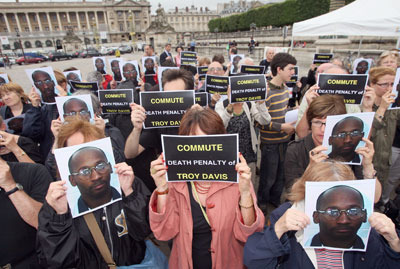
"Our Justice System at Its Worst": DateSet for Troy Davis Execution by David J. Leonard | NewBlackMan ( #TooMuchDoubt)
This week, Georgia announcedits plans to carry out the execution of Troy Davis. While there remains time tothwart this miscarrying of justice, the planned execution should give pause tous all.
In absence of forensicevidence or a murder weapon, an all-white jury convicted Davis of the 1989murder of a police officer in Savannah. The basis of the conviction was the witness testimony of nine individuals(7 eyewitnesses and 2 "jailhouse snitches"), many of who have subsequentlyspoken about police pressure. Infact, since his conviction, all but two of the prosecution's non-policewitnesses have recanted or contradicted their own testimonies, leaving theconviction in doubt. At the sametime, 9 individuals have signed affidavits implicating another individual who happensto be one of the two witnesses who have not reversed on originaltestimony. Notwithstanding thesesignificant doubts raised during the appeals process, one that has neverallowed for his defense team to fully explore the recanting witness testimony,Davis' conviction has remained, resulting in the issuing of his death warrant yesterday.
As part of its announcedplan to stop the execution of Davis, the NAACP described the injustice in thefollowing way: "This is our justice system at its very worst, and we are aliveto witness it. There is just too much doubt." Callingfor people to take action to save Troy Davis' life, his case points tolarger racial issues that demand action as well.
His conviction and thedecision to proceed with his execution should give pause given the research onrace and witness identification. According to the Innocence Project, 75% of wrongful convictionsoverturned by DNA were the result of witness misidentification. "While eyewitness testimony can bepersuasive evidence before a judge or jury, 30 years of strong social scienceresearch has proven that eyewitness identification is often unreliable" reportsthe InnocenceProject. "Research shows that the human mind is not like a tape recorder;we neither record events exactly as we see them, nor recall them like a tapethat has been rewound. Instead, witness memory is like any other evidence at acrime scene; it must be preserved carefully and retrieved methodically, or itcan be contaminated."
One of the sources ofcontamination is clearly race and the myriad of assumptions that result from aninstitutionalized system of stereotyping. In "Cross-Racial Identification Errors in CriminalCases," Sheri Lynn Johnson highlights the unreliable nature of "eye-witness" testimony, a fact that isexacerbated in cross-racial situations. Evidence from actual cases and in research studies elucidate the ways inwhich race and the larger social meanings attached to blackness play asignificant role within the process of witness identification. In a study conducted with whitestudents at University of Illinois and black students at Howard University,researchers showed them pictures of 10 white and 10 black individuals for asecond and half; then, they were are asked to recall the pictures from a seriesof other photos. According toElizabeth F. Loftus, in EyewitnessTestimony:
[T] he subjects were clearly better able to identifymembers of their own race. This study was later duplicated with the addition ofAsian students. Again [African Americans] had greater difficulty recognizingfaces of whites and Asians. Interestingly, however, whites and Asians hadrelatively little problem in identifying members of each other's race – thoughboth had trouble identifying [African Americans]. ( from review of book )
The psychological obstaclesfacing witnesses along with the ways in which race further complicates theprocess is well documented. Yet,we continue to rely on witness testimony within the criminal justicesystem. The power of the whiteracial frame illustrates the reasonable doubt inherent in eyewitnesstestimony. In a society whereblack is akin to criminal, so much so that within the dominant imaginationthere exist a distinct category, the "criminalblackman" (Russell, 1998, p. 3), itis crucial to reflect on what is at stake with Troy Davis: his life and so manyothers.
The planned execution ofTroy Davis also points to a larger question of the racial application of thedeath penalty within the United States. Accordingto David Dow, 35 years into the return of the death penalty "It remains asracist and as random as ever." Referencingthe often-cited Baldus Study, which "found that black defendants were 1.7 timesmore likely to receive the death penalty than white defendants and thatmurderers of white victims were 4.3 times more likely to be sentenced to deaththan those who killed blacks," Dow highlights the racist application of thedeath penalty. Cases involving analleged black perpetrator and a white victim are far more likely to result inthe death penalty. Although, "nationwide,blacks and whites are victims of homicide in roughly equal numbers . . . 80percent of those executed had murdered white people."
The issues evident herepoint to the ways in which race impacts the death penalty at every level of theprocess. For example, prosecutors"used peremptory strikes to remove 80%" of qualified African American jurors"in death penalty cases in Houston County, Alabama from 2005 to 2009. In this jurisdiction, over half of alljuries were all-white with the rest having a lone African American member eventhough the the county was 27% of African American.
Likewise, AngelaJ. Davis notes that "of 381 defendants" whose murder charges were dismissed"because prosecutors either concealed exculpatory information or presentedfalse evidence…67 had been sentenced to death." These studies, along withBaldus, all point to the ways in which race and racism operates within the JimCrow application of the death penalty, further demonstrating the issues atstake with Troy Davis.
In 2010, DaveZirin and Etan Thomas highlighted the Davis case, reminding readers, "Wecannot give up on Troy Davis. Every life is precious. He has already been incarceratedsince 1991 – we think it's past time that justice finally prevails." Given the announcement of the impendingexecution, the importance of not giving up on Troy Davis and justice are thatmuch more important. Thecircumstances for Davis and our entire criminal "justice" system are dire. Dowe really need more evidence about everything that is wrong with the deathpenalty? One more mistake? One more lost life? As a precious life is in jeopardy, letour voices be heard!
***
David J. Leonard isAssociate Professor in the Department of Critical Culture, Gender and RaceStudies at Washington State University, Pullman. He has written on sport, videogames, film, and social movements, appearing in both popular and academicmediums. His work explores the political economy of popular culture, examiningthe interplay between racism, state violence, and popular representationsthrough contextual, textual, and subtextual analysis. He is the author of Screens Fade to Black: Contemporary AfricanAmerican Cinema and the forthcoming AfterArtest: Race and the War on Hoop (SUNY Press). Leonard is a regularcontributor to NewBlackMan andblogs @ No Tsuris.
Published on September 07, 2011 15:02
'Left of Black' Launches 2nd Season Sept.12

Webcast Left of Black Launches 2nd SeasonSept. 12
DURHAM, N.C. – Left of Black, a weekly webcast that debuteda year ago, launches its second season on Sept. 12 with scholar, author andpundit Michael Eric Dyson of Georgetown University.
Left of Blackairs at 1:30 p.m. (EST) on Mondays on Duke's Ustream channel, ustream.tv/dukeuniversity.Viewers are invited to participate in a Twitter conversation with Neal andfeatured guests while the show airs using hash tags #LeftofBlack or #dukelive.
Hosted by author MarkAnthony Neal, a professor of black popular culture at Duke University, Left of Black is recorded and producedat the John Hope Franklin Center ofInternational and Interdisciplinary Studies at Duke.
"I definitely see thisprogram as an extension of my desire to make the knowledge produced in and bythe university available to a wider public," Neal said. "It is also achance to highlight the ideas of folk who aren't the standard talkingheads."
Longtime activist and authorBakari Kitwana agrees, adding that "Neal is that rare thoughtleader who blends high-brow intellect with the everyday muses of the commonman. With Left of Black hebrilliantly translated what he does best to the video webcast form."
The show often takesadvantage of the wide range of scholars and authors who visit Duke Universityevery year, but guests also appear on the program via video-conferencesoftware, or Skype.
Catherine Angst, multimediaspecialist, and Jason Doty, administrative manager, tape and produce the showfrom a customized studio. Episodesare immediately made available for download at iTunesU and other social mediasites.
Guests featured during thefirst season include activist and author Cornel West of Princeton University;activist Randall Robinson, the founder of TransAfrica; author Rebecca Walker,journalist Farai Chideya, and Rosa Clemente, the 2008 Green Party vicepresidential candidate. (For a full list of previous guestsAccording to Professor JamesPeterson, director of Africana Studies at Lehigh University and a frequentcommentator on MSNBC, "Leftof Black represents the future of content delivery in theAcademy. "
###
Published on September 07, 2011 09:30
September 6, 2011
"Subway Stories: Sax, Cantor, Riff" (dir. by Julie Dash)
HBO held a contest asking New Yorkers to submit interesting true stories that happened on the subways. The winning stories were then adapted for the film. "Sax, Cantor, Riff" was written and directed by Julie Dash, featuring Taral Hicks (singer), Kenny Garrett (saxaphone), Dan Rous (Cantor) and Sam Rockwell. Produced by Jonathan Demme and Rosie Perez.
Published on September 06, 2011 18:09
Filmaker Julie Dash on WUNC's The State of Things
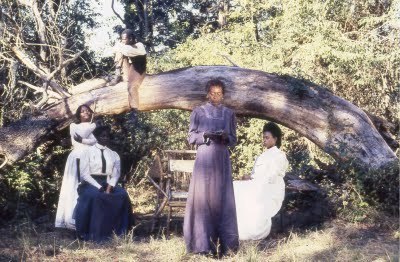 The State of Things with Frank StasioWUNC-FM
The State of Things with Frank StasioWUNC-FMDaughters of the Dust Filmmaker Julie Dash made history with her movie, "Daughters of the Dust." In 1991, it became the first full-length feature by an African-American woman to receive a general theatrical release. The critically acclaimed movie tells the story of the Peazant family, a clan of Gullah Island dwellers who are divided by the decision to leave their isolated life and move to the mainland. "Daughters of the Dust" will be screened at The Nasher Museum of Art at Duke University on Thursday as part of the new "Seeing Black" film series. Host Frank Stasio talks with Dash and with series co-curator Cynthia Greenlee-Donnell about their reflections of the film 20 years later.
Listen Here
Published on September 06, 2011 14:18
The Foreign Exchange on WUNC's 'State of Things'
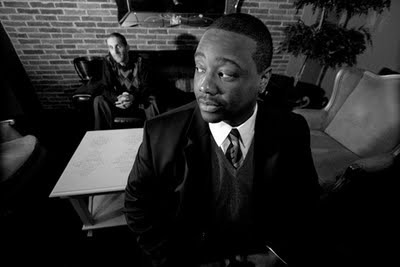 The State of Things with Frank Stasio
WUNC-FM
The State of Things with Frank Stasio
WUNC-FMThe Foreign Exchange
While a young Phonte Coleman was growing up listening to the soulful sounds of artists like Luther Vandross and Chaka Khan in Greensboro, NC, Nicolay Rook was being reared on a similar catalog of musicians in the Netherlands. That musical kinship drew Coleman and Rook to each other on okayplayer.com, an online hip-hop message board, in 2002. The two never met in-person until after they'd put the finishing touches on their critically-acclaimed first album, "Connected." Today, their band, The Foreign Exchange , boasts three albums, a record label imprint and a Grammy nomination. Rook has since relocated to Wilmington, NC to be closer to his bandmate, but he and Coleman continue to work through a long-distance relationship. Host Frank Stasio talks with The Foreign Exchange about the benefits of collaborating in the digital age and gets treated to a live, in-studio performance.
Listen HERE
Published on September 06, 2011 07:35
Tracy Chapman: "Give Me One Reason" | dir. Julie Dash
Tracy Chapman's "Give Me One Reason" directed by Julie Dash, who will discuss her film Daughters of the Dust following the film's screening at Duke University on Thursday, Sept. 8. For me details, HERE
Published on September 06, 2011 05:20
September 5, 2011
High Holy Days: The History and Future of House Music
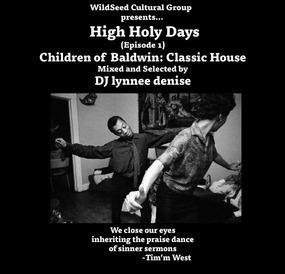
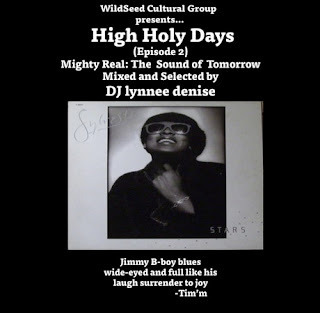
WildSeed Music NYC is proud to present its first ever double mixed cd, High Holy Days: The History and Future of House Music .
Episode 1 "The Children of Baldwin," explores several periods of classic house where both familiar Chicago hits and underground New York City gay club sleepers tell the stories of their sound. Baldwin tells us that: "The responsibility of a writer is to excavate the experience of the people who produced him/her," and I believe the same can be said for the Disc Jockey. Through this mix I hope to bring voice to the untold stories and visibility to the nameless people that generated a global musical movement.
Episode 2, "Mighty Real: The Sound of Tomorrow" pulls on current producers who incorporate elements of classic house, but also push beyond the borders of acceptable dance-floor grooves. Sylvester helped shape a soulful, yet formulaic genre of house music that focuses on spiritual-sexually-inspired falsetto vocals and driving, repetitive disco rhythms. This mix is dedicated to his artistry, fearlessness and commitment to authenticity.
Liner notes for High Holy Days feature two of my favorite scholars and house heads:
Thokazani Mhblambi: "Music's fluidity, its ability to exist in-context and in many other contexts simultaneously, can provide a stimulus towards the direction of freedom. But for house music to do this, it needs to be rescued from the context of excess and accumulation and loaded with transformative content of liberation. It needs to be freed from the ghettoes of global cultures of consumerism, which seek to marginalize the contributions of the church, gospel music, African spirituals, gay-club culture all of which have been foundational to its origins."
Tim'm West:
Jimmy B-boy blueswide-eyed and full like his laughsurrender to joy
We close our eyesinheriting the praise danceof sinner sermons
Sweet serenitybaby powder voudou dustEden where we dance
Published on September 05, 2011 20:12
Mark Anthony Neal's Blog
- Mark Anthony Neal's profile
- 30 followers
Mark Anthony Neal isn't a Goodreads Author
(yet),
but they
do have a blog,
so here are some recent posts imported from
their feed.



